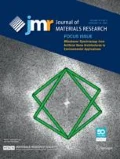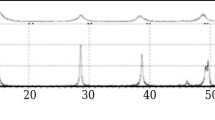Abstract
The synthesis of BaPbO3 from a wide range of mixtures containing metalorganic precursors, nitrate precursors, lead oxides, barium oxide and peroxide was investigated, and the kinetics was analyzed using the Johnson-Mehl-Avrami (JMA) equation. It was found that Ba and Pb stearate soaps and Pb oxalate that were used as metalorganic precursors formed BaCO3 and PbO or Pb3O4 after firing at 440 °C. The formation rate of BaPbO3 from a metalorganic precursor system is not higher than that from the conventional BaCO3-PbO system and does not depend on mixing methods or the kinds of metalorganic precursors but instead on the synthesis atmosphere. In the case of the BaCO3-PbO system, the Avrami exponent (n) is ∼1, indicating that the reaction is controlled by the phase-boundary-contraction interface reaction. For the BaO2-PbO2 system, n has two values ∼1 and ∼0.3, depending on the reaction temperature and time, indicating that the reaction is either controlled by the phase-boundary-contraction interface reaction or diffusion-controlled reaction. In the Ba nitrate-Pb nitrate system, phase-pure BaPbO3 is obtained at 550 °C, which is 250 °C lower than in the case of the BaCO3-PbO system. The value of n for the nitrate system is ∼1.5, indicating that the reaction is controlled by a three-dimensional (3D) diffusion-controlled nucleation mechanism. In the BaO-PbO system, the formation of BaPbO3 started at 350 °C by an exothermic reaction and the content of BaPbO3 in the product was ∼40 wt%, which is independent of reaction temperature as well as time in the temperature range of 350–500 °C.
Similar content being viewed by others
References
M. Yasukawa, N. Murayama: A promising oxide material for high-temperature thermoelectric energy conversion: Ba1−x Srx PbO3 solid solution system. Mater. Sci. Eng. B 54, 64 (1998).
A.W. Sleight, J.L. Gillson, P.E. Bierstedt: High-temperature superconductivity in the BaPb1−xBixO3 systems. Solid State Commun. 17, 27 (1975).
R.J. Cava, B. Batlogg, G.P. Espinosa, A.P. Ramirez, J.J. Krajewski W.F. Peck Jr. L.W. Rupp Jr. A.S. Cooper: Superconductivity at 3.5 K in BaPb0.75Sb0.25O3: Why is Tc so low? Nature 339, 291 (1989).
T. Nitta, K. Nagase, S. Hayakawa, Y. Iida: Formation and properties of barium metaplumbate. J. Am. Ceram. Soc. 48, 642 (1965).
K. Vidyasagar, J. Gopalakrishnan, C.N.R. Rao: Synthesis of complex metal oxides using hydroxide, cyanide, and nitrate solid solution precursors. J. Solid State Chem. 58, 29 (1985).
A. Yamanaka, T. Maruyama, T. Atake, Y. Saito: Preparation of BaPbO3 from coprecipitated barium-lead oxalate. Thermochemica Acta 115, 207 (1987).
M.C. Chang, J.M. Wu, S.Y. Cheng, S.Y. Chen: Reaction kinetics and mechanism of BaPbO3 formation. Mater. Chem. Phys. 65, 57 (2000).
P.R. Mort, R.E. Riman: Determination of homogeneity scale in ordered and partially ordered mixtures. Powder Technol. 82, 93 (1995).
P.R. Mort, R.E. Riman: Reactive multicomponent powder mixtures prepared by microencapsulation: Pb(Mg1/3Nb2/3)O3 synthesis. J. Am. Ceram. Soc. 75, 1581 (1992).
F.H. Chung: Quantitative interpretation of x-ray diffraction patterns of mixtures. I. Matrix-flushing method for quantitative multicomponent analysis. J. Appl. Crystallogr. 7, 519 (1974).
D.R. Lide: Handbook of Chemistry and Physics, 83th ed. (CCR Press, New York, 2002), pp. 4–44, 4–65.
H. Ikushima, S. Hayakawa: Electrical properties of BaPbO3 ceramics. Solid State Electron 9, 921 (1966).
P.L. Walker Jr. F. Rusinko Jr. L.G. Austin Gas reactions of carbon, in Advances in Catalysis and Related Subjects, XI, edited by D.D. Eley, P.W. Selwood, and P.B. Weizs (Academic Press Inc., New York, 1959), pp. 133–221.
O.C. Wilson Jr. R.E. Riman: Morphology control of lead carboxylate powders via anionic substitutional effects. J. Colloid Interface Sci. 167, 358 (1994).
A.S. Shaikh, G.M. Vest: Kinetics of BaTiO3 and PbTiO3 formation from metalorganic precursors. J. Am. Ceram. Soc. 69, 682 (1986).
X. Wang, C. Zhao, Z. Wang, F. Wu, M. Zhao: Synthesis of BaTiO3 nanocrystals by stearic acid gel method. J. Alloy Compd. 204, 33 (1994).
I. Barin: Thermochemical Data of Pure Substances. (Weinheim, Germany, New York, 1989).
J.D. Hancock, J.H. Sharp: Method of comparing solid-state kinetic data and its application to the decomposition of kaolinite, brucite, and BaCO3. J. Am. Ceram. Soc. 55, 74 (1972).
M. Avrami: Kinetics of phase change, I: General theory. J. Chem. Phys. 7, 121103 (1939).
M. Avrami: Kinetics of phase change, II: Transformation-time relations for random distribution of nuclei. J. Chem. Phys. 8, 212 (1940).
M. Avrami: Kinetics of phase change, III: Granulation, phase change, and microstructure. J. Chem. Phys. 9, 177 (1941).
C.L. Sun, H.W. Wang, M.C. Chang, M.S. Lin, S.Y. Chen: Characterization of BaPbO3 and Ba(Pb1−xBix)O3 thin films. Mater. Chem. Phys. 78, 507 (2002).
S.F. Hulbert: Models for solid-state reactions in powdered compacts: A review. Br. Ceram. Soc. J. 6, 11 (1967).
Author information
Authors and Affiliations
Corresponding author
Rights and permissions
About this article
Cite this article
Tani, Ji., Popov, G., Mort, P.R. et al. Precursor and processing effects on BaPbO3 formation kinetics. Journal of Materials Research 21, 584–596 (2006). https://doi.org/10.1557/jmr.2006.0071
Received:
Accepted:
Published:
Issue Date:
DOI: https://doi.org/10.1557/jmr.2006.0071



